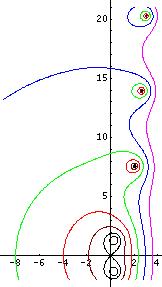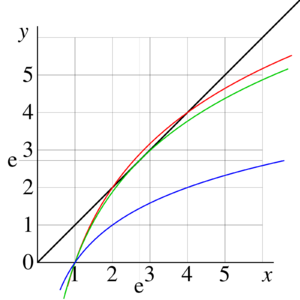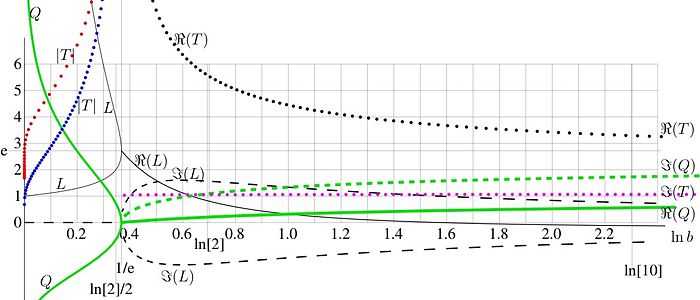Fixed point: Difference between revisions
imported>Alexander Wiebel (typos) |
imported>Dmitrii Kouznetsov m (→Projectors: misprint) |
||
| Line 124: | Line 124: | ||
is fixed point of projector <math>P</math>. | is fixed point of projector <math>P</math>. | ||
In common use are projectors of the 3-dimensional space to 2-dimensional space. Such projectors allow to make flat pictures of | In common use are projectors of the 3-dimensional space to 2-dimensional space. Such projectors allow to make flat pictures of 3-dimensional objects. Any point at the plane of image is fixed point of such a projector. | ||
===Common fixed points=== | ===Common fixed points=== | ||
Revision as of 00:48, 30 July 2008
A Fixed point of a functor is a solution of equation
- ,
that is a point that is mapped to itself.
Simple examples
Elementary functions
In particular, functor can be elementaty function. For example, 0 and 1 are fixed points of function sqrt, because and .
In similar way, 0 is fixed point of sine function, because .
Operators
The functor in the equation, defining a fixed point, can be a linear operator. In this case, the fixed point of the functor is its eigenfunction with eigenvalue equal to unity.
Exponential if fixed point or operator of differentiation D, because
- , with and the reals,
is fixed point of the Fourier operator, defined with its action on a function :
- (3)
in general, functors have no need to be linear, and there is no associativity at application of several functors in row, and parenthesis are necessary in the left hand side of eapression (3). [1]
Fixed points of exponential and fixed points of logarithm
Fixed points can be searched graphically. Fig.1 shows the graphical search of fixed points of logarithm, i.e., solutions of the equation
- (10)
There are no real solutions for this equation, but there are two complex-congjugated solutions and . However, the value of cannot be estimated well from the figure (1), but the straigtgorward iteration allows the precise estimate. Few hundreds of iterations are sufficient to get error of order of last significant figure in the approximation
- (11)
Fixed points of exp are not the same as those of ln
Fixed points of logarithm should not be confised with fixed points of exponential, shown in FIgure 2. These fixed points are solutions of equations
- (12)
They can be expressed also as solution of equation
- (13) for some integer
For example, at
- (13)
is fixed point of the exponential, but is not fixed point of natural logarithm.
In the case of exponential and natural logarithm, all fixed points are complex. However, the real fixed points exist at . For example, at , number e is fixed point of both, and ; and at , numbers 2 and 4 are their fixed points.
Finding of real fixed points is presented graphically in Figure 3. The black curve represents the identical function in the left hand side of equation
- (14)
the colored curves represent the function in the right hand side for , , and . In the last case, there are no real solutions, but the complex fixed points are complex numbers and . Within few hundred iterations of equation (14), they can be approcimated with many decimal digits;
- (15).
Such evaluation can be performed in real time with any high level algorithmic language – Maple, Mathematica, that allow to specify number of correct decimal digits desirable in the result.
The mathematical proof of existence of the fixed points of the exponential can be found in the old paper by Helmuth Kneser [2]. Recently, Genryk Trappmann had generalized this proof for the exponentiation of arbitrary real base, but his theorem is not yet uploaded.
Tetration
The fixed points of logarithm determine the asymptotic properties of analytic extension of tetration . In some range of the complex -plane, the tetration can be approximated with asymptotic
(32)
where
(33)
and are fixed complex numbers, dependent on . Possible values of fixed points are shown with thin black curves versus logarithm on base . At , the fixed points are complex; the real part is shown with solid curve, the imaginary part is shown with dashed curve.
Green curves in Figure 4 represent the parameter in (33), again, the dased curve shows the imaginary part, and real and imaginary parts of the asymptotic period . See article tetration for details.
Projectors
Functor on the space is called Projector, if for all .
Any function of subset of functions is fixed point of projector .
In common use are projectors of the 3-dimensional space to 2-dimensional space. Such projectors allow to make flat pictures of 3-dimensional objects. Any point at the plane of image is fixed point of such a projector.
Common fixed points
The same element may be fixed point of several projectors.
Sometimes, such common fixed points can be approximated using iterations. If there are two projectors and , then the sequence of elements, approximating the common fixed point of these projectors can be constructed in the following way:
Such a sequence is used to approximate the amplitude-phase behavior of ultra-short pulses in the FROG systems [3].
Notes
- ↑ Note that that there is certain ambiguity in commonly used writing of mathematical formulas, omiting sign * of multiplication; in equation (3), expression does not mean that is multiplied to value of ; it means that result of action of operator on function , which is also a function, is evaluated at argument .
- ↑ Helmuth Kneser. "Reelle analytische Lösungen der Gleichung und verwandter Funktionalgleichungen". Journal für die reine und angewandte Mathematik 187: 8-67.
- ↑ Amplitide and phase in ultra-short pulses can ne measured only with another ultra-short pulse; so, some nonlinear interaction is used to recover the temporal behavior of the pulse. The set of equations (usually two) is solved numerically, projecting the probe function to the spaces of solutions of each equation sequentially.


![{\displaystyle F[L]=L}](https://wikimedia.org/api/rest_v1/media/math/render/svg/952aaf5e42e45721926eb1deb75cdc9613a87971)





































































